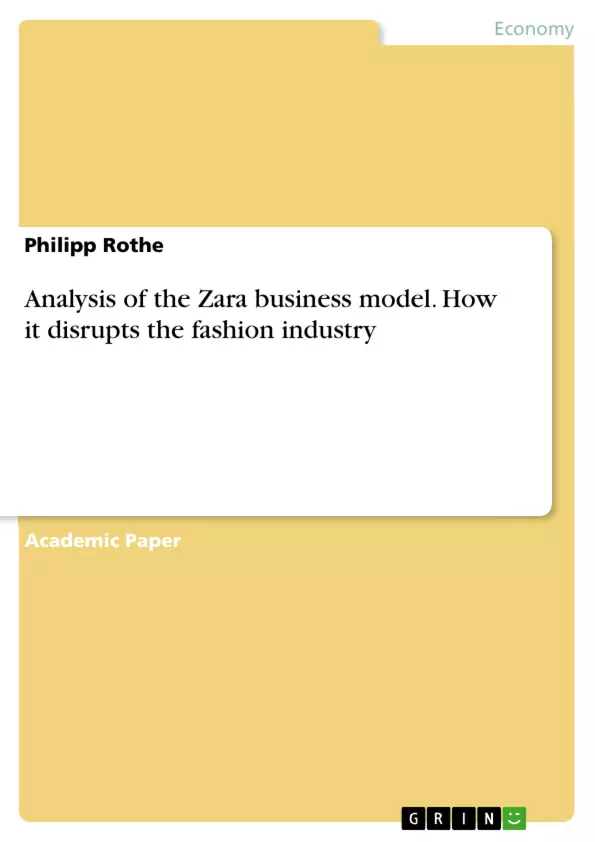The purpose of this paper is to identify how Zara maintains its leadership through its specialization in quick fashion by analysing the internal and external industry environment by utilizing analytic tools, such as Porter’s 5 Forces and SWOT. This paper will also take a deeper look into the company's business model and marketing strategies.
An in-depth case approach is adopted based on extensive secondary research that includes literature and press releases. In response to these findings, we suggest strategic recommendations by maintaining its status as a "quick fashion" pioneer, as well as dominating the emerging "ultra-fast fashion".
Zara is the Spanish flagship store belonging to one of the world's biggest and most successful fashion apparel retailers, Inditex. The company is a multinational clothing company with thousands of in-store locations and an e-commerce presence.
Table of Contents
- 1. Introduction
- 2. Industry analysis
- 3. Business model
- 4. Marketing Strategy
- 5. Zara's industry disruption
- 6. Recommendations
Objectives and Key Themes
This paper aims to analyze Zara's sustained leadership in the fast fashion industry by examining its internal and external environments using analytical tools like Porter's Five Forces and SWOT analysis. It will delve into Zara's business model and marketing strategies, ultimately offering strategic recommendations for maintaining its competitive edge in both the existing "quick fashion" and emerging "ultra-fast fashion" markets.
- Zara's competitive advantage in the fast fashion industry
- Analysis of Zara's business model and its efficiency
- Evaluation of Zara's marketing strategies and their effectiveness
- Assessment of the external competitive landscape using Porter's Five Forces
- Strategic recommendations for Zara's future growth and market dominance
Chapter Summaries
1. Introduction: This chapter introduces Zara, a prominent Spanish clothing retailer and subsidiary of Inditex, the world's largest apparel retailer. It highlights Zara's extensive global presence, diverse product offerings (including women's, men's, and children's clothing, cosmetics, perfumes, and household products), and rapid growth since its founding in 1975. The chapter emphasizes Zara's ability to quickly adapt to evolving fashion trends and consumer demands, a core element of its success.
2. Industry analysis: This chapter analyzes Zara's external environment through the lens of Porter's Five Forces. It assesses the threat of new entrants (low due to high capital requirements and economies of scale), the bargaining power of suppliers (low due to Zara's vertical integration and control over much of its production), the rivalry among existing competitors (high due to the intensely competitive nature of the ready-to-wear industry), the bargaining power of customers (moderate, as Zara’s responsiveness to trends balances customer influence), and the threat of substitute products (low, due to Zara's focus on quality and differentiation from lower-cost competitors).
3. Business model: This chapter explores Zara's efficient and distinctive business model, emphasizing its vertical integration and exceptional organization. It details Zara's value proposition: high-quality products at mid-range prices with rapidly changing collections, supported by its flagship stores and online presence. The chapter also highlights Zara's unique approach to inventory management, characterized by limited production seasons and high product turnover, minimizing warehousing and inventory costs.
Keywords
Zara, Inditex, fast fashion, ultra-fast fashion, business model, vertical integration, Porter's Five Forces, SWOT analysis, marketing strategy, competitive advantage, industry analysis, supply chain, consumer demand, global retail.
Zara: A Comprehensive Language Preview - Frequently Asked Questions
What is the purpose of this document?
This document provides a comprehensive overview of a paper analyzing Zara's success in the fast fashion industry. It includes a table of contents, objectives and key themes, chapter summaries, and keywords.
What topics are covered in the paper?
The paper analyzes Zara's sustained leadership by examining its internal and external environments using Porter's Five Forces and SWOT analysis. It delves into Zara's business model, marketing strategies, and provides strategic recommendations for maintaining its competitive edge in the fast fashion and ultra-fast fashion markets.
What are the key themes explored in the paper?
Key themes include Zara's competitive advantage, its efficient business model, the effectiveness of its marketing strategies, the competitive landscape (using Porter's Five Forces), and strategic recommendations for future growth.
What is Zara's competitive advantage according to the paper?
The paper explores Zara's competitive advantage through its analysis of its business model, marketing strategies, and its ability to adapt quickly to changing trends and consumer demands. Its vertical integration and efficient supply chain are highlighted as key factors.
How does the paper analyze Zara's business model?
The paper analyzes Zara's business model by examining its vertical integration, exceptional organization, value proposition (high-quality, mid-range priced products with rapidly changing collections), and its unique inventory management approach with limited production seasons and high product turnover.
What marketing strategies are evaluated in the paper?
The paper evaluates Zara's marketing strategies and their effectiveness in contributing to its market dominance. While specifics aren't detailed in this preview, the effectiveness is assessed in relation to its overall competitive position.
How does the paper use Porter's Five Forces?
The paper uses Porter's Five Forces to analyze Zara's external competitive landscape, assessing the threat of new entrants, bargaining power of suppliers and buyers, rivalry among competitors, and the threat of substitute products.
What kind of recommendations are offered in the paper?
The paper offers strategic recommendations for Zara's future growth and continued market dominance, considering both the existing "quick fashion" and emerging "ultra-fast fashion" markets.
What are the key chapters covered in the paper?
The paper includes chapters on Introduction, Industry Analysis, Business Model, Marketing Strategy, Zara's industry disruption, and Recommendations.
What are the keywords associated with this paper?
Keywords include Zara, Inditex, fast fashion, ultra-fast fashion, business model, vertical integration, Porter's Five Forces, SWOT analysis, marketing strategy, competitive advantage, industry analysis, supply chain, consumer demand, and global retail.
- Quote paper
- Philipp Rothe (Author), 2021, Analysis of the Zara business model. How it disrupts the fashion industry, Munich, GRIN Verlag, https://www.grin.com/document/1357307




